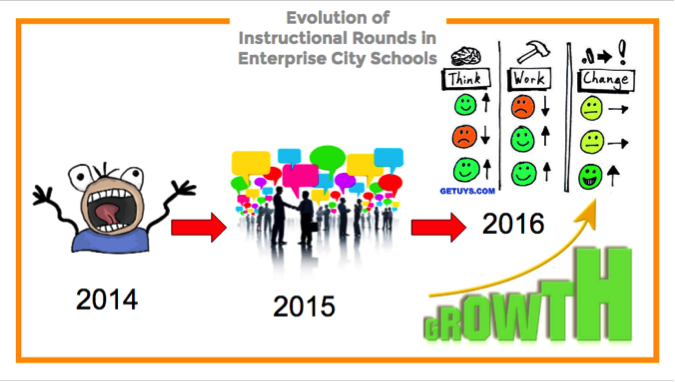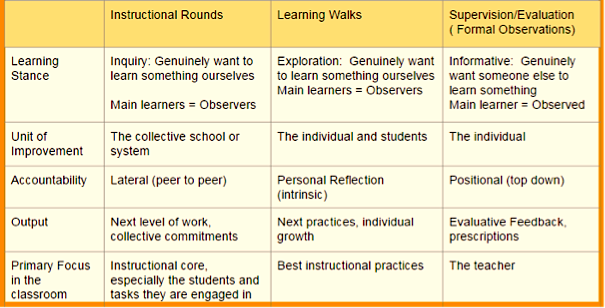ABPC has been promoting the Instructional Rounds process (originally devised by Harvard’s Richard Elmore) for a number of years, showcasing the concept with annual school visits across the state every spring. We’re excited that some districts are adapting the idea for their own schools. In this guest post, Lori Snell, Coordinator of Instructional Support for Enterprise City, shares some insights about her system’s three-year effort.
At a recent meeting of our regional Key Leaders Network, I had the opportunity to share the process our district has gone through in implementing instructional rounds as an instructional improvement strategy. Because I am a visual learner, I created this image to summarize how this has truly become a “High Payoff Strategy” for our district.
Three years after we first experimented with instructional rounds in 2014, Enterprise is experiencing significant improvement in our professional culture and in the teaching and learning going on in our schools. One reason for our success is that we are never satisfied. We continually strive to improve not only the instructional round process, through feedback and adjustments, but also the teaching and learning in our schools through dialogue, reciprocity, and praxis.
Our growing pains
At the onset of instructional rounds, the idea of groups of colleagues visiting classrooms was a foreign concept to everyone in our district. Instructional rounds were led by our instructional partners/coaches at each school. Every round followed the same agenda in every school, with a districtwide focus on student engagement.
We had a rough start. Fear of evaluation, fear of criticism, anxiety about what people on the rounds wanted to see, and confusion about receiving feedback were only a few of the obstacles we had to overcome. As a district, we attempted 6 rounds per year for each of our nine district schools. For each round, a different group of building-based colleagues would participate, with the goal that as many teachers in the district as possible would have an instructional rounds experience that first year.
Redesigning from experience
As we began to question the process and listen to our teachers, we started making adjustments for the second year of instructional rounds. Although we continued to try 6 rounds at each school with a different team of teachers each time, we became more strategic, adjusting the number of teachers entering classrooms, the number of times a group would visit any classroom, and the amount of time we spent in the classrooms. These fairly minor adjustments alleviated some of the anxiety and enabled our teachers to feel more comfortable engaging in deeper dialogue with their visiting colleagues.
 In our third year, we have become even more strategic and intentional by developing a plan that is using instructional rounds as part of each school’s effort to meet improvement goals. We challenged ourselves to differentiate for our schools based on their specific ACIP goals, professional learning needs, and Educate AL plans.
In our third year, we have become even more strategic and intentional by developing a plan that is using instructional rounds as part of each school’s effort to meet improvement goals. We challenged ourselves to differentiate for our schools based on their specific ACIP goals, professional learning needs, and Educate AL plans.
Often, schools and teachers feel as though they are working on 10 different things at once. As we began the year, we hoped that pre-planning and coordination of our improvement efforts would help eliminate that overwhelming feeling and enable faculties to work diligently in one area and draw on multiple pieces of evidence of growth.
The instructional leadership team at each school met with a Director of Instruction and myself to reflect on the goals and instructional needs of the school. Together we developed a plan to hold three instructional rounds with one consistent building-based team. A team consisted of 10-15 teachers where the principal was the lead learner and facilitator of the rounds. Each school developed its own IR focus for this year, with input from the faculty as well as analysis of their school’s multiple sources of data. Some of those focus areas include learning targets, formative assessments, literacy across the curriculum, and rigorous student work.
Introducing learning walks
The addition of schoolwide and districtwide half-day “learning walks” led by instructional partners have taken the instructional improvement strategy to yet another more intimate level of personal growth.
It was extremely important that our teachers understood the difference between instructional rounds and learning walks and used the professional language appropriately.
- Instructional rounds are a collective responsibility of the faculty to grow the school for greater student achievement.
- A learning walk, in contrast, is an opportunity for teachers to visit classrooms for individual reflection and personal growth, often looking for ideas and inspiration. Below is a chart I shared during training for each of the building based instructional round teams.
Continuous improvement is key
I am extremely proud of the growth our schools have experienced as a result of participating and taking ownership of their school’s instructional rounds. We have the school-based instructional round teams collaborating across schools on the best ways to share instructional round results with faculty so that it is meaningful and everyone will feel involved.
Here are some ways instructional rounds are producing high rewards for Enterprise City Schools:
- We’ve grown a strong professional adult culture. Teachers in Enterprise City Schools are opening their doors to one another. From teachers within their building to teachers from other schools in the district to administrators and central office staff, there is an openness and comfort to classroom visits. This instructional improvement strategy has brought our district closer together and teachers are sharing resources and ideas across the district.
- Our main focus is teaching and learning. We are shifting the focus in our district to teaching and learning. We are having more dialogue about what good instruction looks like and how we know students are learning. The more dialogue we have, the closer we come to having a common language around instruction and the more we can grow toward our school and district goals.
- Authentic PLCs are emerging in our schools. In our third year we shifted to instructional round teams that stay together all year long. As a result, the IR teams are becoming a close-knit group with common understandings and beliefs about teaching and learning. These emerging professional learning communities are becoming models for classroom observations. Teacher leaders are developing in all schools across the district.
- We are empowering teachers. Teachers feel more empowered to make decisions about teaching and learning. School improvement has truly become about the school and those working within the school. Everyone plays a part and has a role in student achievement and how best to accomplish it.
Lori Snell is Coordinator of Instructional Support for the Enterprise (AL) City Schools. Before assuming her current role in August 2015, Lori was the Instructional Partner at Enterpise High School for three years. She was a junior high and then high school science teacher in Enterprise City for 13 years. Follow her on Twitter @LoriSnell3




0 Comments on "Instructional Rounds: A “High Payoff” Strategy for Enterprise City"